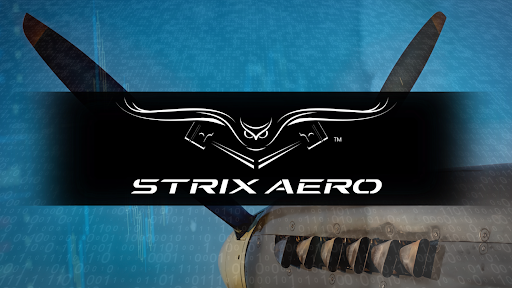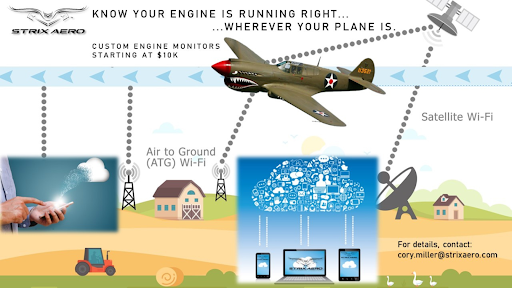Enhance the Safety & Reliability of Your Piston Engine Plane With an Aircraft Engine Monitoring System

The inherent danger within taking to the skies is a key contributor to the thrill, there’s no denying that. Whether you’re chasing that thrill or you’re simply looking to take to the air just for the sake of flying, churning that engine over and letting its thrust lift you into the sky yields a feeling found nowhere else. And yet, there’s that thought in the back of your mind, the thought that arises from the very same danger that prompts the excitement. Is your engine still up to the task after all these flights? How can you know for certain? Sure, you maintain it impeccably, but was everything covered in the last overhaul? What if something fails well before its expected lifetime?
The question then remains, how can you know whether your engine is up to the task before your next engine overhaul? Not to worry, there’s a simple solution. An engine monitoring system (EMS) is an instrument consisting of multiple sensors and a centralized computer to monitor the performance of an engine and, most importantly, track any abnormalities that could signify larger issues at play. Just about any modern application where an engine’s operation is a safety concern will incorporate an EMS, both for the sake of the engine and for the sake of those who are depending on that engine.
These systems offer a great deal of information to pilots and can even offer insight on how to address certain system malfunctions while in the air. So, before something like pre-detonation becomes a blown engine at altitude, an EMS system can alert the pilot to the issue. And while having an EMS system is better than no EMS system at all, you’ll find that not all are created equally. Let’s take a look at some of the common shortcomings among EMS systems and how we at Strix Aero are overcoming them.
Common Problems Amongst Engine Monitoring Systems in Aircraft

Naturally, EMS systems can be incredibly complex, even where they ought not to be. Whether it be from the difficulty of installation to the communication of integral data to the pilot, having an EMS system that is useful when it counts is just as important as having one at all. In fact, we’ve often found that many pilots operating planes with an EMS won’t use the data simply due to the hassle they can create.
In addition to this, there can be significant barriers to outfitting an engine with an EMS that is not standardly equipped with one. In those cases where there is great difficulty involved with installing the system, the cost to implement the system can grow substantially. Or, in cases where an EMS cannot be easily customized to plane, there comes the risk of the data not being useful or not being utilized.
So, the challenge is then to have an EMS that can easily be installed in unique planes, can provide pilots with useful insights mid-flight, and can provide substantial information beyond topical engine datapoints to enable engine tuning and optimization between flights. While many EMSs have come to the market to try to do just that, none do it quite like our own.
The Solution: Engine Monitoring with Strix Aero

Cost Effectiveness
Our engine monitoring solution addresses all of the major issues we’ve seen among EMSs on the market today. Foremost, our cost of implementation is incredibly competitive, especially given the value we provide. In our analysis, our EMS comes in at about half the cost of comparable EMSs currently available, all while providing a great deal of utility and addressing the other common issues found in other EMS systems.
Form Factor
The form factor of our EMS can be easily customized to a wide variety of cockpit orientations. If you’d like to keep your controls true to the way they were designed, our EMS can operate without a display. You can get live information on your cell phone, tablet, or laptop, all without altering the look of the controls of your plane. Or, if you’d rather a display to populate critical information, there are multiple display options for you to choose from for the best fit for your plane and your piloting preference.
Ease of Use
Next, we addressed the concern of ease of use and ease of implementation into a wide variety of engines. Our experts support customization of the software to provide pilots with easy-to-follow instructions in the event that our EMS finds any engine parameters that exceed their standard operating thresholds. So, not only can you get meaningful information from our EMS in the moments you need it most, you can also rest assured it can be customized to your specific application. We even provide integration services to ensure the system is set up properly on each engine so you can be doubly confident in your flight and your EMS.
Over the Air Data Reporting

One of our most innovative features is our ability to store engine datapoints to the cloud via Wi-Fi (or mobile network) so your flights can be logged for later analysis or interpreted in real time from the air or from the ground. And, of course, engine faults are reported instantly. You can have a flight summary emailed/texted seconds after flight, and if you even have the option for your data to be sent for expert analysis to notify you of any potential safety concerns.
Engine Tuning and Optimization
The capture of all of this data is incredibly useful in-flight for the safety of the pilot, but it’s just as useful on the ground when it comes to tuning the engine to operate as optimally as possible. With the datapoints the Strix Aero EMS collects, an initial evaluation of the engine and tune can give you the peace of mind that your engine is perfectly prepared for your next flight.
The Full Package
When you equip your engine with Strix Aero engine monitoring, you’ll get dyno-level engine data logging as you fly, early detection of common engine failure points, increased ability to detect/prevent engine damage/failure, and precise diagnostic tooling for establishing root causes to logged issues. From reliability to emergency preparedness, we’d argue a Strix Aero EMS is an essential component to your next flight.
The Difference an EMS Makes

To synthesize why you should consider an EMS for your piston-engine plane, it all comes down to safety, reliability, peace of mind, and even cost efficiency. Utilizing specialized sensors and calculations to detect system faults potentially before they become catastrophic is invaluable to pilots, and knowing that the system has an extra set of eyes can assuage concerns you may feel while flying. EMSs are not a replacement for the skill and experience pilots have in knowing their plane, rather they are an enhancement. Utilizing the data they provide, your mastery over your controls can develop even further.
Now, how can an EMS be a cost-efficient piece of equipment for your plane? To be brief, replacing or tuning faulty components that are causing an engine to malfunction will generally be more cost effective than replacing the engine in its entirety, so if the system can warn of faults before serious engine damage occurs, you can see it quickly paying for itself. This can especially be the case for historical planes for which their engines are no longer in production and finding quality replacements grows increasingly difficult year after year.
Why Use an Engine Monitoring System on a WWII Engine?

It may seem counterintuitive that, in our efforts to keep the history of these engines alive, we would involve components not true to the time period. After all, there were no computers monitoring the engines as warbirds carried out their missions; that was the job of the pilot. But, just as there’s a reason we no longer use lead paint in our homes, there’s good reason to implement an engine monitoring system on a WWII engine.
Sure, the fact that these engines still exist is a testament to their longevity and the skill of their designers, but you’ll want more assurance than “It hasn’t failed me yet” when it’s powering your warbird. Luckily, there is a solution. While these engines may have been designed and built with technology that’s undeniably dated by modern standards, the tools we use to monitor and test them don’t have to be. We can maintain the authenticity of these engines and all of their core components while integrating modern diagnostic and monitoring capabilities with the implementation of an engine monitoring system.
See You at Strix, Your Engine Monitoring System Provider

The benefit of an EMS is clear; valuable datapoints available at critical moments can make the difference for a successful flight. And, don’t worry, we at Strix Aero specialize in the technical side of your aircraft so you don’t have to. Or, if you’re the kind of person who likes to talk air/fuel ratios and spark timing, we’re more than happy to delve into the details. Let our data supplement your experience as a pilot to increase your awareness of risks and provide optimal fault detection to benefit your safety. Get in touch with us today to see how we can help outfit your plane with the best aircraft engine monitoring system you’ll find on the market.


